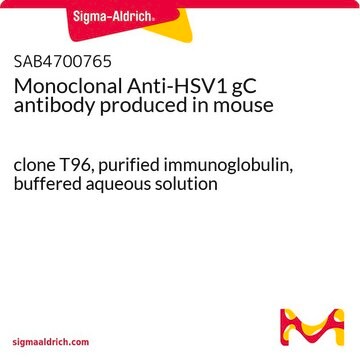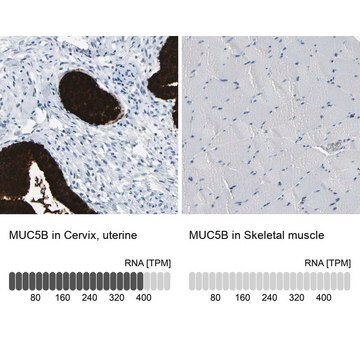推荐产品
生物源
mouse
品質等級
100
500
共軛
unconjugated
抗體表格
culture supernatant
抗體產品種類
primary antibodies
無性繁殖
MRQ-18, monoclonal
描述
For In Vitro Diagnostic Use in Select Regions (See Chart)
形狀
buffered aqueous solution
物種活性
human
包裝
vial of 0.1 mL concentrate (291M-14)
vial of 0.5 mL concentrate (291M-15)
bottle of 1.0 mL predilute (291M-17)
vial of 1.0 mL concentrate (291M-16)
bottle of 7.0 mL predilute (291M-18)
製造商/商標名
Cell Marque™
技術
immunohistochemistry (formalin-fixed, paraffin-embedded sections): 1:50-1:200
同型
IgG1κ
控制
colon
運輸包裝
wet ice
儲存溫度
2-8°C
視覺化
cytoplasmic
基因資訊
human ... MUC2(4583)
一般說明
Mucins are a diverse group of complex, highly glycosylated extracellular proteins. Mucin 2 (MUC2) protects the gastric and intestinal epithelium from chemical and mechanical injury. Anti-MUC2 reactivity is normally seen in goblet cells of the small intestine and colon and is associated with mucinous carcinomas, including those of the gastrointestinal tract and ovary. MUC2 immunohistochemistry is useful for identifying colonic, gastric, and esophageal carcinomas.
Mucins are high molecular weight glycoproteins which constitute the major component of the mucus layer that protects the gastric epithelium from chemical and mechanical aggressions. In humans, at least 14 mucin genes have been identified that code for the mucin proteins. They are designated as MUC1, MUC2, MUC3, MUC4, MUC5AC, MUC5B , MUC6 , MUC7, MUC8, MUC9, MUC11, MUC12, MUC13 and MUC16. Mucins share a common feature of a tandem-repeat domain rich in serine and threonine residues. These amino acid residues are potential O-glycosylation sites for attachment of the O-glycan chains that constitute up to 80% of the molecular weight of the final mucin glycoprotein.
The heterogeneous pattern of mucin expression, including the expression of the intestinal mucin MUC2, may provide new insights into the differentiation pathways of gastric carcinoma. The pattern of mucin expression may also be used as a clue to bring new insights into the biological behaviour of distinct clinicopathological entities related to the localisation of gastric carcinoma, namely proximal and distal gastric carcinomas. Pinto-de-Sousa et al. have shown in a comprehensive study of gastric carcinomas evaluated for expression of several mucins (MUC1, MUC2, MUC5AC and MUC6) that: (1) mucin expression is associated with tumour type (MUC5AC with diffuse and infiltrative carcinomas and MUC2 with mucinous carcinomas) but not with the clinico-biological behaviour of the tumours; and (2) mucin expression is associated with tumour location (MUC5AC with antrum carcinomas and MUC2 with cardia carcinomas), indirectly reflecting differences in tumour differentiation according to tumour location.
The following generalities apply to the patterns of Mucin expression:
MUC1 expression: apical surfaces of most epithelial cells in breast, GI, respiratory, and GU tracts.
MUC2 expression: specifically expressed in goblet cells of the small intestine & colon.
Colonic CAs – 65%, Gastric CAs – 42%, Esophageal CAs – 17%
Rare outside of GI tract – with exception of; mucinous ca of breast, clear cell-type CAs of the ovary.
The heterogeneous pattern of mucin expression, including the expression of the intestinal mucin MUC2, may provide new insights into the differentiation pathways of gastric carcinoma. The pattern of mucin expression may also be used as a clue to bring new insights into the biological behaviour of distinct clinicopathological entities related to the localisation of gastric carcinoma, namely proximal and distal gastric carcinomas. Pinto-de-Sousa et al. have shown in a comprehensive study of gastric carcinomas evaluated for expression of several mucins (MUC1, MUC2, MUC5AC and MUC6) that: (1) mucin expression is associated with tumour type (MUC5AC with diffuse and infiltrative carcinomas and MUC2 with mucinous carcinomas) but not with the clinico-biological behaviour of the tumours; and (2) mucin expression is associated with tumour location (MUC5AC with antrum carcinomas and MUC2 with cardia carcinomas), indirectly reflecting differences in tumour differentiation according to tumour location.
The following generalities apply to the patterns of Mucin expression:
MUC1 expression: apical surfaces of most epithelial cells in breast, GI, respiratory, and GU tracts.
MUC2 expression: specifically expressed in goblet cells of the small intestine & colon.
Colonic CAs – 65%, Gastric CAs – 42%, Esophageal CAs – 17%
Rare outside of GI tract – with exception of; mucinous ca of breast, clear cell-type CAs of the ovary.
品質
 IVD |  IVD |  IVD |  RUO |
聯結
MUC2 Positive Control Slides, Product No. 291S, are available for immunohistochemistry (formalin-fixed, paraffin-embedded sections).
外觀
Solution in Tris Buffer, pH 7.3-7.7, with 1% BSA and <0.1% Sodium Azide
準備報告
Download the IFU specific to your product lot and formatNote: This requires a keycode which can be found on your packaging or product label.
其他說明
For Technical Service please contact: 800-665-7284 or email: service@cellmarque.com
法律資訊
Cell Marque is a trademark of Merck KGaA, Darmstadt, Germany
未找到合适的产品?
试试我们的产品选型工具.
Seog-Yun Park et al.
Archives of pathology & laboratory medicine, 131(10), 1561-1567 (2007-10-10)
Although identification of the primary tumor in patients with metastatic adenocarcinoma has a profound clinical impact, diagnosing the organ of origin is frequently difficult. Because none of the individual immunohistochemical markers used for tissue identification are both site specific and
Emad A Rakha et al.
Modern pathology : an official journal of the United States and Canadian Academy of Pathology, Inc, 18(10), 1295-1304 (2005-06-25)
Mucins are a large family of glycoproteins expressed by many epithelial cells and their malignant counterparts. Much interest has been focused on expression of its members in breast cancer because of their potential role as prognostic indicators and their involvement
T Mizoshita et al.
Histology and histopathology, 22(3), 251-260 (2006-12-14)
We have previously demonstrated links between clinicopathological findings and phenotypes using several gastric and intestinal phenotypic markers in stomach and pancreatic cancers. However, the clinicopathological significance of the phenotype and Cdx2 expression has hitherto remained unclear in colorectal carcinogenesis. We
Fionnuala P O'Connell et al.
Archives of pathology & laboratory medicine, 129(3), 338-347 (2005-03-02)
Breast carcinoma often metastasizes to the gastrointestinal tract, especially the stomach, where it is frequently difficult to distinguish from a primary gastric carcinoma. To evaluate the utility of immunohistochemical stains in differentiating primary gastric carcinomas from metastatic breast carcinomas. Mucosal
P Chaves et al.
Diseases of the esophagus : official journal of the International Society for Diseases of the Esophagus, 18(6), 383-387 (2005-12-13)
Intestinal metaplasia is a prerequisite criterion for the diagnosis of Barrett's metaplasia and the sole columnar esophageal lining associated with malignancy. It is recognized by the presence of goblet cells, but columnar non-goblet elements, producing gastric or intestinal proteins, are
我们的科学家团队拥有各种研究领域经验,包括生命科学、材料科学、化学合成、色谱、分析及许多其他领域.
联系技术服务部门

